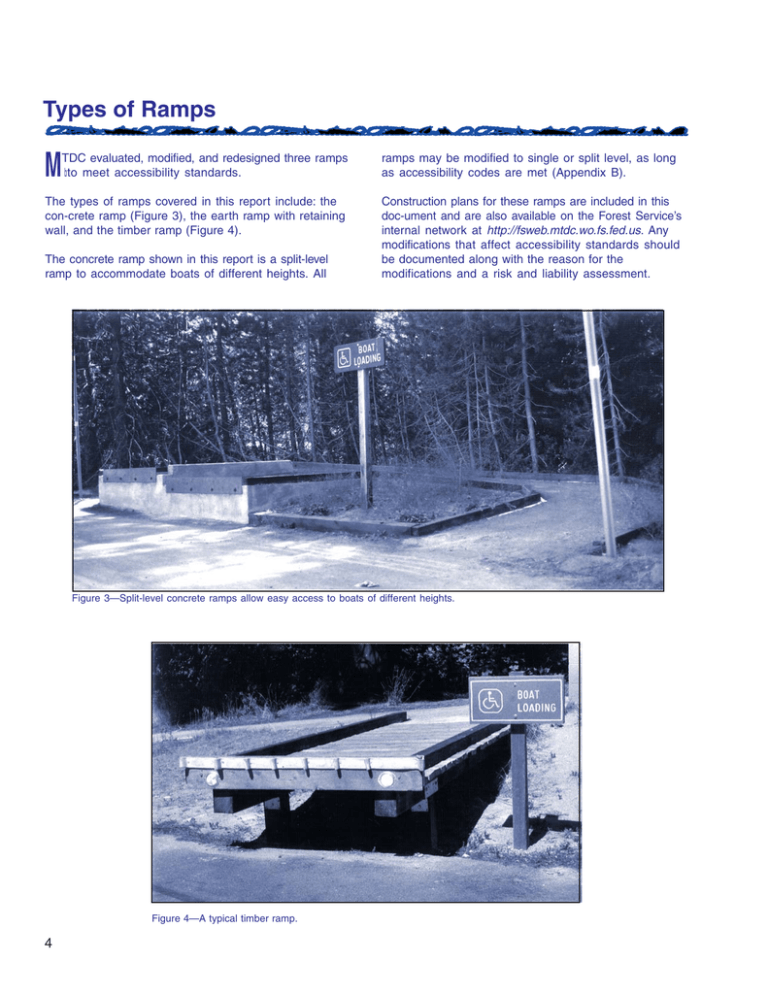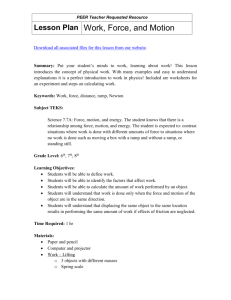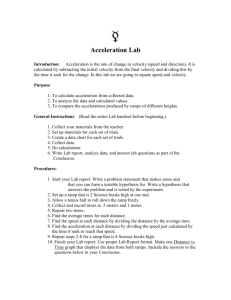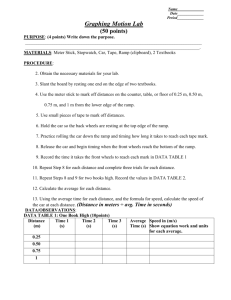M Types of Ramps
advertisement

Types of Ramps M ramps may be modified to single or split level, as long as accessibility codes are met (Appendix B). The types of ramps covered in this report include: the con-crete ramp (Figure 3), the earth ramp with retaining wall, and the timber ramp (Figure 4). Construction plans for these ramps are included in this doc-ument and are also available on the Forest Service’s internal network at http://fsweb.mtdc.wo.fs.fed.us. Any modifications that affect accessibility standards should be documented along with the reason for the modifications and a risk and liability assessment. TDC evaluated, modified, and redesigned three ramps bto meet accessibility standards. The concrete ramp shown in this report is a split-level ramp to accommodate boats of different heights. All Figure 3—Split-level concrete ramps allow easy access to boats of different heights. Figure 4—A typical timber ramp. 4 Costs C osts associated with the construction of these ramps vary greatly depending on the location, site preparation, construction materials, and construction method (pri-vate contractor, agency employees, Job Corps, or volunteer groups). Several of the sites MTDC visited were developed with the assistance of organizations such as the Lions Club and the Boy Scouts of America. 5 Employee Safety W hen agency employees, volunteers, or charitable organizations are helping to develop a site, you should conduct a site inspection and develop a job hazard analysis before construction. Use the job hazard analysis and safety meetings to inform workers of potential dangers. Post the job hazard analysis at the construction site and ensure that workers wear appropriate personal protective equipment. 6 The Ramp and Boarding Platform A n accessible ramp and boarding platform allow boaters to get into the boat before it is placed in the water (Figure 5). The boat is pulled alongside the ramp so it is next to the boarding platform. With the boat in position, the passengers can board. A 1¦4-inch-thick steel plate bolted to the end of the platform and protruding up a minimum of 2 inches will prevent wheelchairs from rolling off (Figure 6). After passengers are on board, safely seated, and secured, the driver can proceed to the boat launch. When unloading, the process works in reverse. Figure 5—The boarding platform allows passengers to get into a boat while it is still on land, reducing the risks during loading and unloading. Figure 6—The 1¦4-inch-thick steel plate on the end of the platform allows boat trailers to get close to the platform while preventing wheelchairs from rolling off. 7 Siting Ramps P latforms are generally sited along the perimeter of a parking area near the water (Figure 7). Ramps should be built on flat ground. This is especially important when building a split-level ramp. Otherwise, the boat will rise or fall as it is pulled alongside the ramp, pre-venting the split levels from working as intended. Straight access to the ramp will allow drivers to align the boat closer to the boarding platform. Drivers need a straight approach 40 feet before and 40 feet after the ramp for the vehicle and trailer to enter and exit. The area should be kept clear of brush and debris that can interfere with the line of sight. Rubber fenders or bumpers should be placed alongside the front of the ramp and the platform to prevent them from being damaged by boats or vehicles. Bumpers should not be very thick because the boat will not be able to get close enough to the platform for easy loading and unloading. The platform should be even with the edge of the roadway or parking area. When modifying an existing site for an accessible ramp, be sure curbs do not interfere with access to the platform. For an individual with limited mobility, inches can make a big difference in gaining safe access from the platform to the boat (Figure 8). Figure 7—A timber boarding platform built alongside an existing restroom. Figure 8—A ramp recessed behind curbs makes loading and unloading difficult. 8



